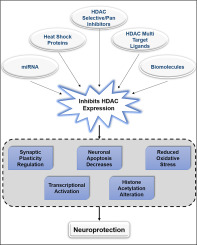Our official English website, www.x-mol.net, welcomes your feedback! (Note: you will need to create a separate account there.)
Pharmacological intervention of histone deacetylase enzymes in the neurodegenerative disorders.
Life Sciences ( IF 6.1 ) Pub Date : 2020-01-08 , DOI: 10.1016/j.lfs.2020.117278 Rohan Gupta 1 , Rashmi K Ambasta 1 , Pravir Kumar 2
Life Sciences ( IF 6.1 ) Pub Date : 2020-01-08 , DOI: 10.1016/j.lfs.2020.117278 Rohan Gupta 1 , Rashmi K Ambasta 1 , Pravir Kumar 2
Affiliation

|
Reversal of aging symptoms and related disorders are the challenging task where epigenetic is a crucial player that includes DNA methylation, histone modification; chromatin remodeling and regulation that are linked to the progression of various neurodegenerative disorders (NDDs). Overexpression of various histone deacetylase (HDACs) can activate Glycogen synthase kinase 3 which promotes the hyperphosphorylation of tau and inhibits its degradation. While HDAC is important for maintaining the neuronal morphology and brain homeostasis, at the same time, these enzymes are promoting neurodegeneration, if it is deregulated. Different experimental models have also confirmed the neuroprotective effects caused by HDAC enzymes through the regulation of neuronal apoptosis, inflammatory response, DNA damage, cell cycle regulation, and metabolic dysfunction. Apart from transcriptional regulation, protein-protein interaction, histone post-translational modifications, deacetylation mechanism of non-histone protein and direct association with disease proteins have been linked to neuronal imbalance. Histone deacetylases inhibitors (HDACi) can be able to alter gene expression and shown its efficacy on experimental models, and in clinical trials for NDD's and found to be a very promising therapeutic agent with certain limitation, for instance, non-specific target effect, isoform-selectivity, specificity, and limited number of predicted biomarkers. Herein, we discussed (i) the catalytic mechanism of the deacetylation process of various HDAC's in in vivo and in vitro experimental models, (ii) how HDACs are participating in neuroprotection as well as in neurodegeneration, (iii) a comprehensive role of HDACi in maintaining neuronal homeostasis and (iv) therapeutic role of biomolecules to modulate HDACs.
中文翻译:

组蛋白脱乙酰酶在神经退行性疾病中的药理干预。
逆转衰老症状和相关疾病是一项艰巨的任务,其中表观遗传是至关重要的角色,包括DNA甲基化,组蛋白修饰;染色质重塑和调节与各种神经退行性疾病(NDD)的进展有关。各种组蛋白脱乙酰基酶(HDACs)的过表达可以激活糖原合酶激酶3,从而促进tau的过度磷酸化并抑制其降解。虽然HDAC对于维持神经元形态和大脑动态平衡很重要,但同时,如果放松,这些酶也会促进神经变性。不同的实验模型还证实了HDAC酶通过调节神经元凋亡,炎症反应,DNA损伤,调节细胞周期和代谢功能障碍而引起的神经保护作用。除转录调控外,蛋白质-蛋白质相互作用,组蛋白翻译后修饰,非组蛋白蛋白质的脱乙酰化机制以及与疾病蛋白质的直接关联都与神经元失衡有关。组蛋白脱乙酰基酶抑制剂(HDACi)能够改变基因表达并在实验模型上显示其功效,并且在NDD的临床试验中被发现是非常有前途的治疗剂,具有一定的局限性,例如非特异性靶标作用,同种型-选择性,特异性和有限数量的预测生物标志物。在这里,我们讨论了(i)各种HDAC在体内和体外实验模型中脱乙酰过程的催化机制,(ii)HDAC如何参与神经保护以及神经变性,
更新日期:2020-01-09
中文翻译:

组蛋白脱乙酰酶在神经退行性疾病中的药理干预。
逆转衰老症状和相关疾病是一项艰巨的任务,其中表观遗传是至关重要的角色,包括DNA甲基化,组蛋白修饰;染色质重塑和调节与各种神经退行性疾病(NDD)的进展有关。各种组蛋白脱乙酰基酶(HDACs)的过表达可以激活糖原合酶激酶3,从而促进tau的过度磷酸化并抑制其降解。虽然HDAC对于维持神经元形态和大脑动态平衡很重要,但同时,如果放松,这些酶也会促进神经变性。不同的实验模型还证实了HDAC酶通过调节神经元凋亡,炎症反应,DNA损伤,调节细胞周期和代谢功能障碍而引起的神经保护作用。除转录调控外,蛋白质-蛋白质相互作用,组蛋白翻译后修饰,非组蛋白蛋白质的脱乙酰化机制以及与疾病蛋白质的直接关联都与神经元失衡有关。组蛋白脱乙酰基酶抑制剂(HDACi)能够改变基因表达并在实验模型上显示其功效,并且在NDD的临床试验中被发现是非常有前途的治疗剂,具有一定的局限性,例如非特异性靶标作用,同种型-选择性,特异性和有限数量的预测生物标志物。在这里,我们讨论了(i)各种HDAC在体内和体外实验模型中脱乙酰过程的催化机制,(ii)HDAC如何参与神经保护以及神经变性,


























 京公网安备 11010802027423号
京公网安备 11010802027423号